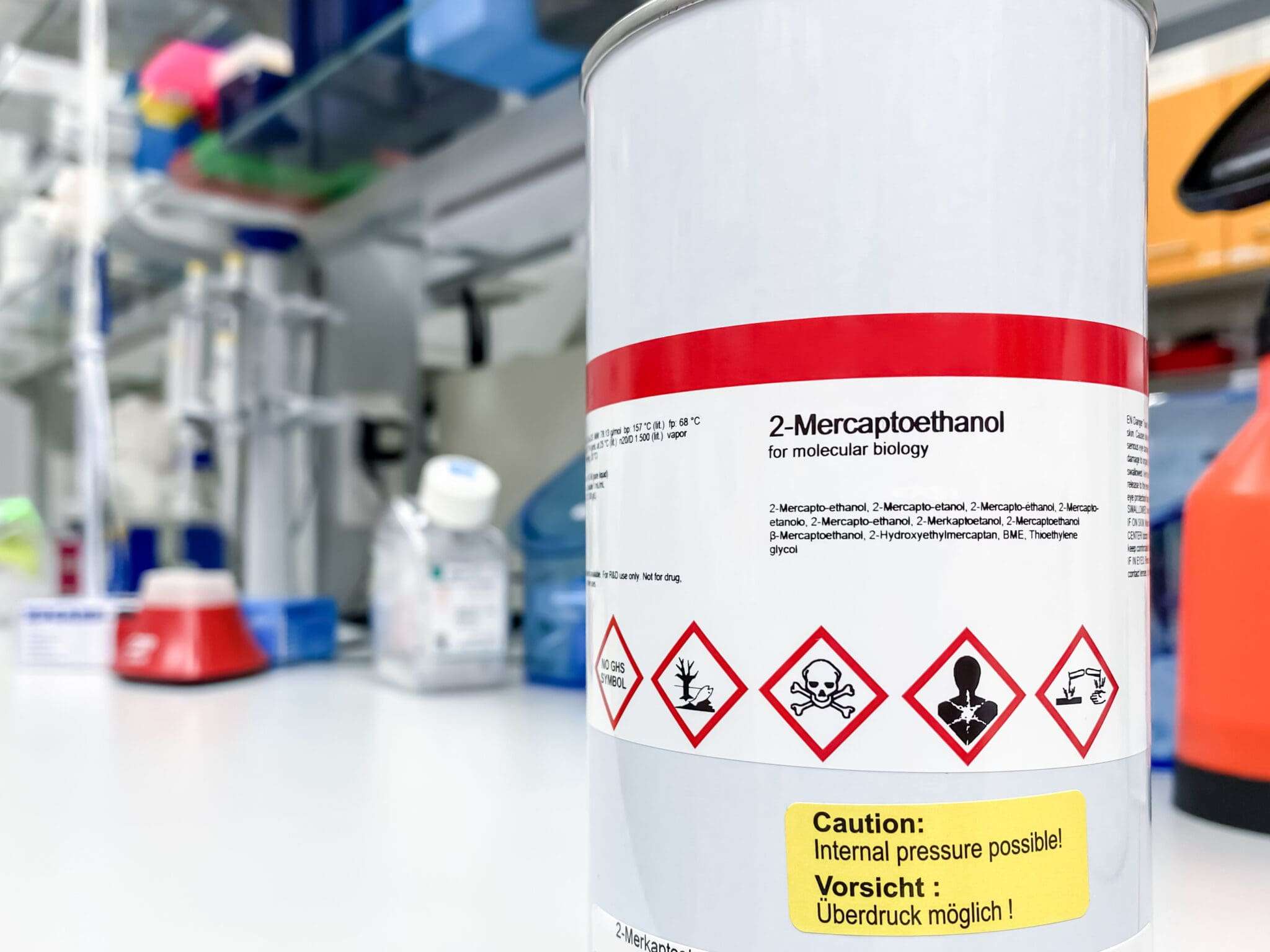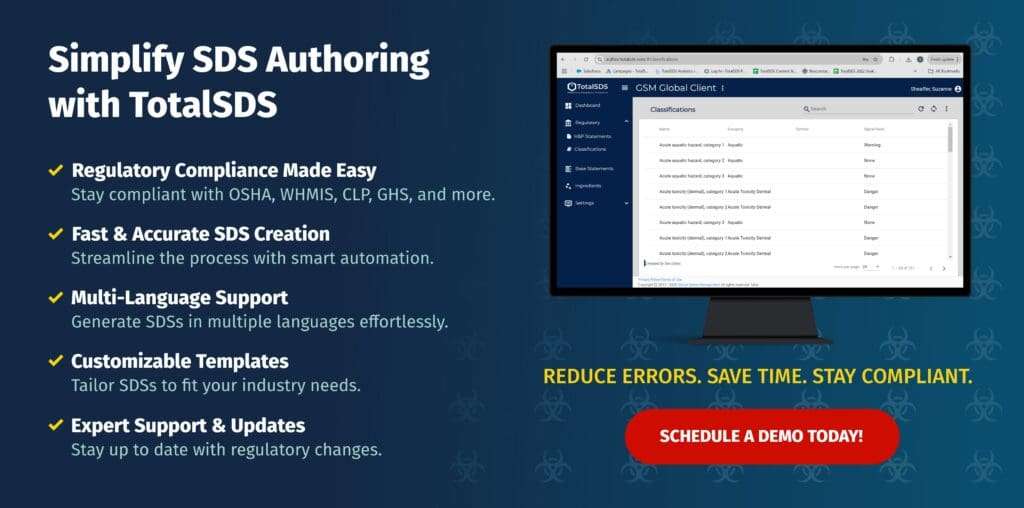Effective chemical management is a critical aspect of ensuring workplace safety and regulatory compliance, especially in environments that handle hazardous substances. Whether you’re managing a small laboratory or a large industrial operation, proper chemical management minimizes the risks of accidents, enhances operational efficiency, and ensures compliance with government regulations.
In this blog post, we’ll discuss the importance of chemical management, key best practices, and how safety data sheets (SDS) play a pivotal role in this process. We’ll also explore how safety data sheet solutions, like those offered by TotalSDS, can streamline and enhance chemical management efforts.
What is Chemical Management?
Chemical management refers to the practices, procedures, and tools used to control and monitor the use of chemicals within a workplace. This includes everything from selecting and procuring chemicals to storing, using, disposing of, and keeping records of chemical substances. The goal of chemical management is to ensure that all chemicals are handled in a safe, efficient, and compliant manner, while minimizing the risks of accidents, health issues, and environmental damage.
Managing chemicals with SDS (Safety Data Sheets) is a core component of any successful chemical management strategy. SDSs provide essential information about the properties, hazards, handling, and disposal of chemicals, helping employees work with them safely and legally. Regulatory agencies like OSHA (Occupational Safety and Health Administration) and the EPA (Environmental Protection Agency) require employers to maintain proper chemical management practices and keep up-to-date safety data sheets to ensure safe use of chemicals.
Why Chemical Management is Important
Chemical management is not just about regulatory compliance; it’s about protecting people, property, and the environment. Proper chemical management reduces the risk of hazardous exposures, spills, and accidents, all of which can result in serious injuries, illnesses, or even fatalities. A robust chemical management system also helps organizations avoid fines, penalties, and reputational damage by ensuring they meet environmental and safety regulations.
Inadequate chemical management can lead to accidents like chemical spills, fires, or dangerous reactions, all of which can have devastating consequences. Furthermore, poor chemical management can result in improper chemical disposal, environmental contamination, and legal repercussions.
Hazard communication ranks high on OSHA’s top violations list. By focusing on best practices in managing chemicals, businesses can ensure safer operations, improve employee morale, and reduce the likelihood of costly incidents. This can ultimately lead to better financial performance, as effective chemical management can reduce costs related to accidents, insurance premiums, and regulatory fines.
Best Practices in Chemical Management
To achieve optimal chemical management, there are several best practices that organizations should implement. These practices help mitigate risks, improve safety, and streamline operations.
1. Proper Labeling
Proper labeling of chemicals is essential to ensure that employees can easily identify the substances they are working with. This includes ensuring that all chemicals are clearly labeled with their correct names, hazards, and handling instructions. Additionally, labels should comply with OSHA’s Globally Harmonized System (GHS) standards, which provide a universal classification system for chemical hazards.
2. Comprehensive Safety Data Sheets (SDS)
Safety Data Sheets are essential documents that provide detailed information about each chemical hazard, safe handling procedures, first aid measures, and storage requirements. Organizations must ensure they have access to up-to-date SDSs for all chemicals they handle. SDSs must be readily accessible to all employees who work with chemicals, and employers should implement a system for regularly reviewing and updating these documents.
3. Employee Training
All employees who handle chemicals should be trained on how to read and interpret SDSs, how to handle chemicals safely, and what to do in the event of an emergency. Regular training ensures that employees are aware of the potential hazards associated with chemicals and understand how to follow proper safety procedures.
4. Hazard Communication Program
A well-established hazard communication program is vital for ensuring that everyone in the workplace is aware of the chemicals they may come into contact with and the associated risks. This program should include proper labeling, signage, and clear communication of safety protocols and procedures. An SDS management system can streamline this process by providing digital access to hazard information.
5. Regular Audits and Inspections
Regular audits and inspections are necessary to ensure that chemical management procedures are being followed correctly. These audits should evaluate the effectiveness of labeling, inventory control, SDS management, and employee training programs. Audits help identify potential issues or areas for improvement and ensure compliance with safety regulations.
6. Sustainable Chemical Disposal
Safe disposal of chemicals is a critical aspect of chemical management. Hazardous chemicals must be disposed of in accordance with local, state, and federal regulations to prevent harm to human health and the environment. Implementing a sustainable waste management system ensures that chemicals are disposed of properly and helps minimize a company’s environmental footprint.
Role of Safety Data Sheets (SDS) in Chemical Management
Safety Data Sheets are an essential part of managing chemicals. They provide detailed instructions on how to handle, store, and dispose of chemicals safely. SDSs are not only required by OSHA and other regulatory agencies but also serve as a vital tool for employees working directly with hazardous substances.
Using a comprehensive SDS management system can help businesses organize, access, and update SDSs easily. TotalSDS offers both SDS management software and SDS authoring software to streamline the process of ensuring compliance. With TotalSDS software, businesses can maintain an up-to-date, digital library of SDSs that employees can access in real-time, ensuring they always have the information they need to work safely.
SDS management software can automate the process of reviewing and updating SDSs, ensuring that businesses are always in compliance with regulatory changes. It also allows companies to track chemicals more efficiently, ensuring that inventory is accurate and hazardous materials are handled according to best practices.
Enhancing Chemical Management with SDS Software
Effective chemical management is essential for creating a safe and compliant workplace. By following best practices such as maintaining accurate inventories, ensuring proper labeling, training employees, and managing SDSs effectively, businesses can minimize the risks associated with handling chemicals. Using advanced SDS management software, such as TotalSDS, helps streamline and enhance these practices, ensuring safety and compliance at every step.
Whether you are managing a small laboratory or a large industrial operation, implementing a robust chemical management system will help protect your employees, the environment, and your bottom line.



